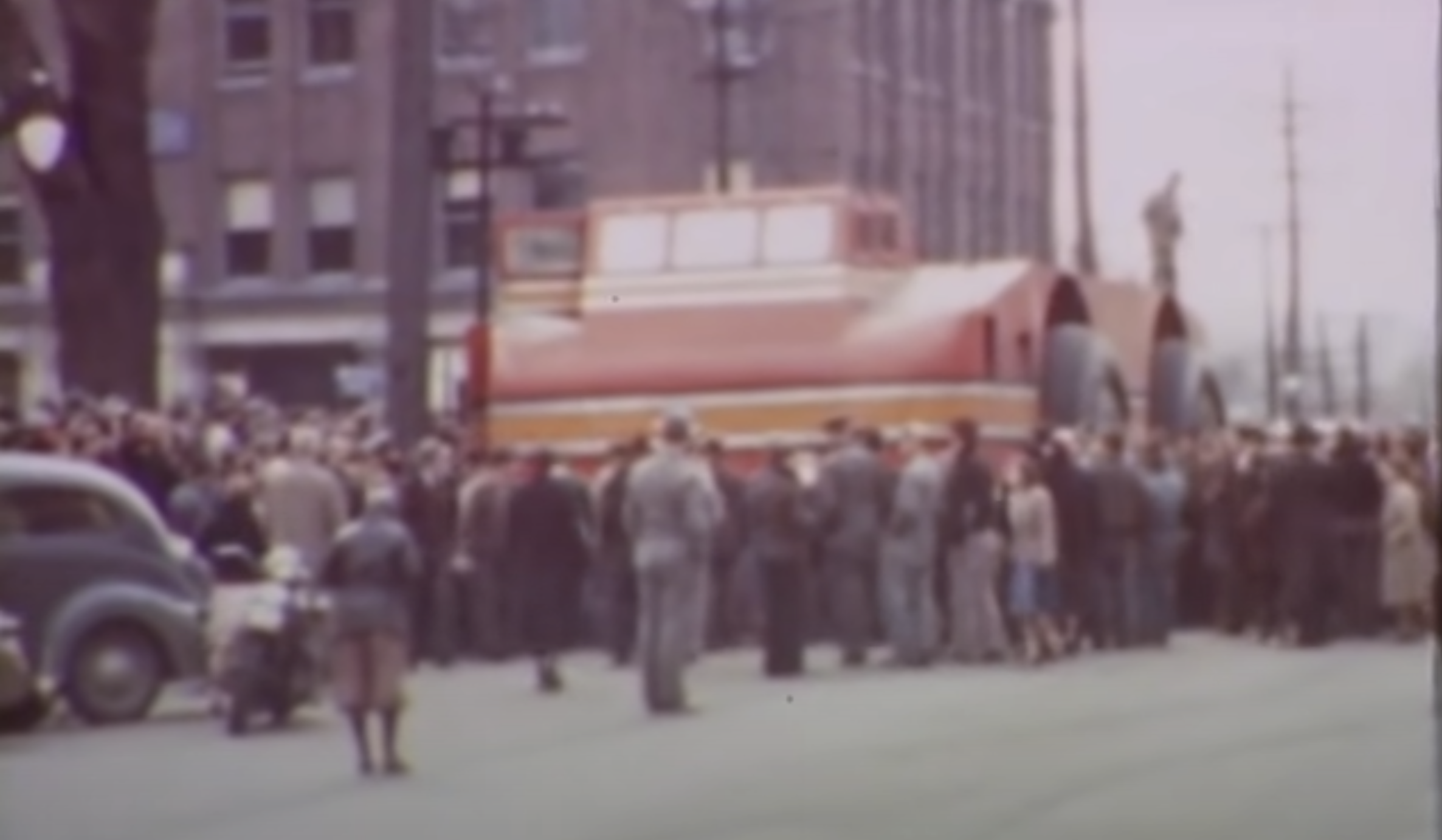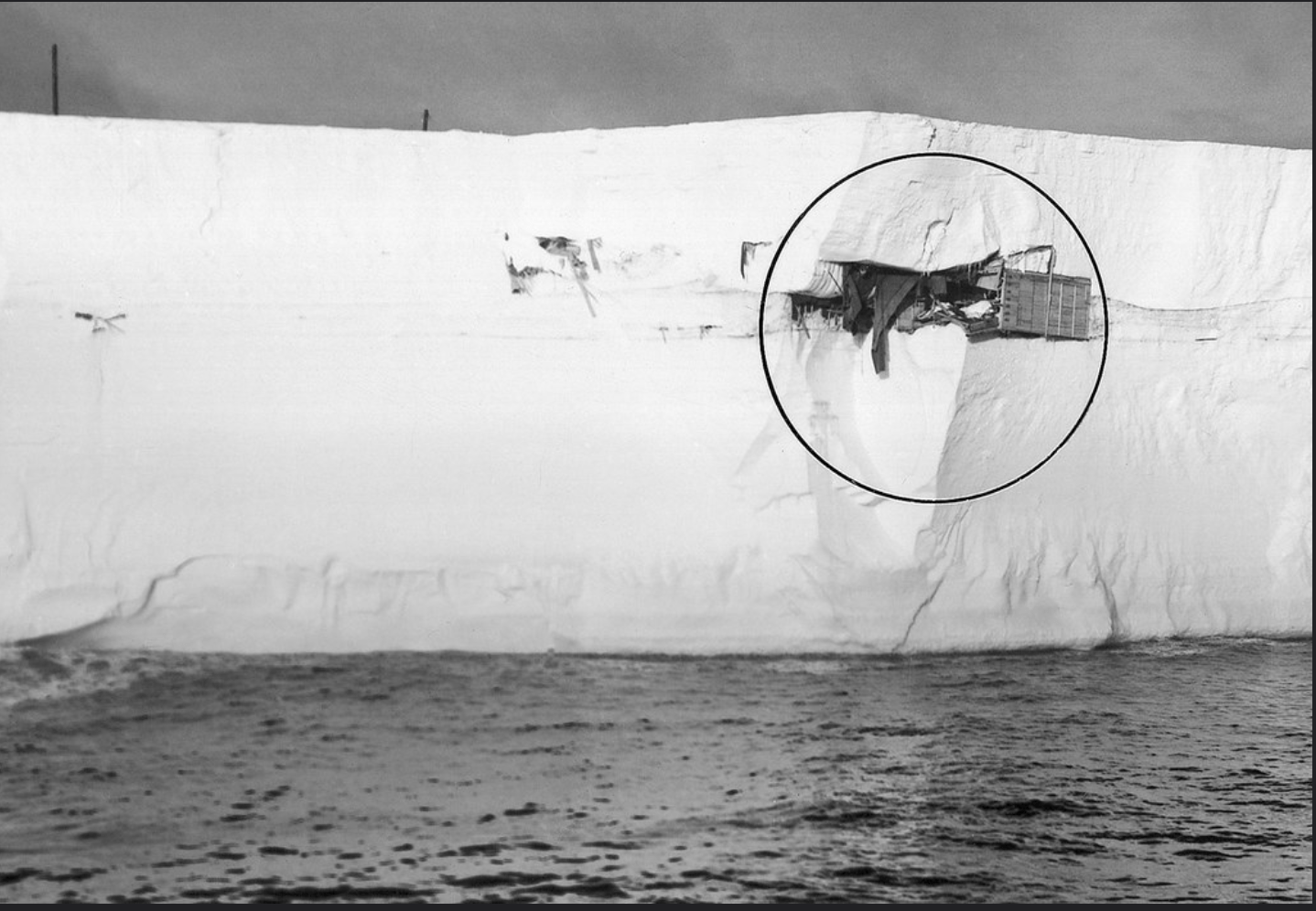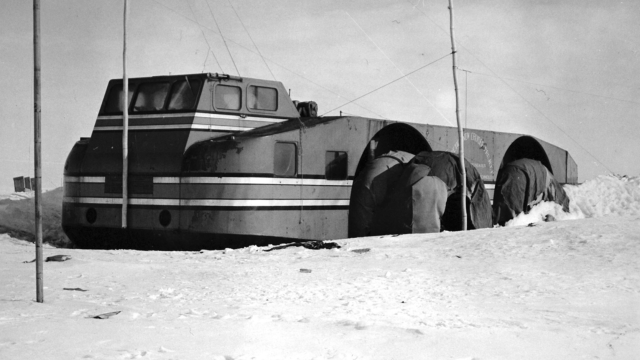Everything about the name “Antarctic Snow Cruiser” fires up my imagination. This long-forgotten behemoth was so ahead of its time and so doomed for failure that I was surprised to find that, somehow, Gizmodo’s never really delved deep into this fascinating vehicle.
I mean, just look at the size of it when surrounded by regular-sized humans in Westfield, New York in 1939:
The Antarctic Snow Cruiser was designed by the scientists and engineers at Chicago’s Armour Institute of Technology (now the Illinois Institute of Technology) to tackle the unique challenges of Antarctic research. It was dreamed up by professor at the Institute and Antarctic explorer Dr. Thomas Poulter, and took two years to design and 11 weeks to construct.
The Cruiser was designed to be a movable science lab. It had crew quarters, making it almost like an RV, a very advanced RV. This monster measured 16.76 m long, weighed more than 33.5 tonnes fully loaded, and cost $US150,000 ($218,550) to build in 1939 dollars, which would make it a $US2.7 ($4) million piece of equipment today. It’s completely smooth 3.05 m-tall tires were somehow meant to traverse ice crevasses.
Hagerty has a full breakdown of the amazing technology put into this unique vehicle:
Designed particularly for traversing crevasses, the vehicle had long overhangs at either end, as well as retractable wheels to assist in this process. The retracting wheels, which tucked the wheels into housings where they were warmed by engine exhaust gasses, also prevented the smooth, treadless 3.05 m Goodyear tires from cracking in the cold. (Yes, we will discuss the rubber more in a bit.)
The Cruiser could accommodate a crew of four or five, and the flat upper area between the 6.10 m wheelbase was intended to hold a small plane brought along for the purpose of aerial surveys of the terrain. Up front, in an elevated control room, sat the Snow Cruiser driver and charter. Underneath the control room, beneath a catwalk, were the machine shop, snow melter, and a variety of generators, pumps, and hoists.
Just ahead of the front wheels was the engine room, housing a pair of Cummins inline-six diesel engines that combined for 300 horsepower. The engines were paired with two generators and four electric motors, courtesy of General Electric, which also combined for 300 hp. Behind the front wheels were the photo dark room and gallery, followed by the crew’s living and sleeping quarters. At the rear wheels you’d find the store room; way in the back was the storage compartment for two spare tires.

For all of it mechanical magnificence, its first trip out was a disaster. The Cruiser was built in Chicago, but it was departing for the Antarctic from Boston. That meant it had to make it 1,642 km across America’s heartland at a top speed of 48 km/h. Even at those slow speeds on fairly modern roads, travel would proved incredibly challenging:
The Snow Cruiser got hit by a truck in Indiana and later suffered fuel pump trouble. Six miles outside of Lima, Ohio, it hit the corner of a bridge and fell into a small creek, where it remained for three days. If it couldn’t handle the treacherous, unforgiving landscape of middle America, how was the Snow Cruiser ever going to handle, say, Antarctica? These were appropriate questions to ask, but meanwhile, excited by a press blitz that included an October 1939 cover story in Popular Mechanics, an estimated 125,000 people came out to see the vehicle trundle like a half-tranquilized bear along its journey. Many were enamoured of its majesty — and yet increasingly suspect of its supposed capabilities.
Between the accidents and stops for crowds, the Snow Cruiser did manage to make it to Boston for its scheduled departure. It left Boston aboard the North Star on November 12, 1939, but once it got to the Antarctic two months later the problems became catastrophic. Even getting off the boat, its most successful Antarctic manoeuvre, was totally biffed:
Once it hit the ice it proved as useless as people feared. The Cruiser was dropped at the research settlement Little America III on the Ross Ice Shelf to the south of the Bay of Whales. There all 33.5 tonnes of it sunk into the multiple feet of snow, its smooth tires spinning helplessly. It just didn’t have enough traction or horsepower to get its huge bulk moving. Surprisingly, it did manage a 148 km trip in reverse, but didn’t move much after that.
The Cruiser wasn’t much of a car, but it turned into a great crew quarters, keeping four scientist toasty warm during challenging conditions when temperatures could reach -45 degrees Celsius. There were plans to bring new and improved parts back to Antarctic to get the Cruiser going again, but America’s gear up towards World War II ended any dreams of movement. The entire base, along with the Cruiser, was abandoned on December 22, 1940.
Various expeditions would return to the Cruiser, finding it relatively intact. A group in 1946 found that all it really needed was air in the tires. They also left bamboo poles, which allowed a 1958 expedition to locate it under several feet of snow and ice.
That was the last anyone ever saw the Cruiser, in its entirety anyway. A photo taken from a Naval ship might actually show its final resting place. It was taken from a U.S. Naval ship on March 13, 1963 in the Antarctic’s Ross Sea:

This iceberg contains some of the remains of Little America III, under 7.62 m of ice and 483 km away from where it was originally built. A naval pilot who did a fly by saw that there were still supplies sitting packed on to the shelves. There was no sign of the Cruiser, however it could be encased deeper into the iceberg. Either way, the failed behemoth is now, most likely, at the bottom of the ocean
